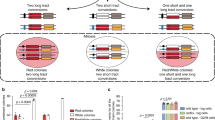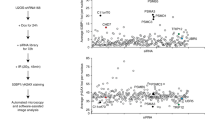Abstract
Cell cycle checkpoints are signal transduction pathways activated after DNA damage to protect genomic integrity1. Dynamic spatiotemporal coordination is a vital, but poorly understood aspect, of these checkpoints. Here, we provide evidence for a strikingly different behaviour of Chk2 versus Nbs1, key mediators of the ataxia-telangiecatesia-mutated (ATM)-controlled checkpoint pathways induced by DNA double-strand breaks (DSBs)1,2. In live human cells with DSBs restricted to small sub-nuclear areas, Nbs1 was rapidly recruited to the damaged regions and underwent a dynamic exchange in the close vicinity of the DSB sites. In contrast, Chk2 continued to rapidly move throughout the entire nucleus, irrespective of DNA damage and including the DSB-free areas. Although phosphorylation of Chk2 by ATM occurred exclusively at the DSB sites, forced immobilization of Chk2 to spatially restricted, DSB-containing nuclear areas impaired its stimulating effect on p53-dependent transcription. These results unravel a dynamic nature of Nbs1 interaction with DSB lesions and identify Chk2 as a candidate transmitter of the checkpoint signal, allowing for a coordinated pan-nuclear response to focal DNA damage.
This is a preview of subscription content, access via your institution
Access options
Subscribe to this journal
Receive 12 print issues and online access
$209.00 per year
only $17.42 per issue
Buy this article
- Purchase on Springer Link
- Instant access to full article PDF
Prices may be subject to local taxes which are calculated during checkout




Similar content being viewed by others
References
Rouse, J. & Jackson, S.P. Interface between the detection, signaling, and repair of DNA damage. Science 297, 547–551 (2002).
Bartek, J., Falck, J. & Lukas, J. CHK2 kinase — a busy messenger. Nature Rev. Mol. Cell Biol. 2, 877–886 (2001).
Limoli, C.L. & Ward, J.F. A new method for introducing double-strand breaks into cellular DNA. Radiat. Res. 13, 160–169 (1993).
Rogakou, E.P., Boon, C., Redon, C. & Bonner, W.M. Megabase chromatin domains involved in DNA double-strand breaks in vivo. J. Cell Biol. 146, 905–916 (1999).
Wang, Y. et al. BASC, a super complex of BRCA1-associated proteins involved in the recognition and repair of aberrant DNA structures. Genes Dev. 14, 927–939 (2000).
Falck, J., Petrini, J.H., Williams, B.R., Lukas, J. & Bartek, J. The DNA damage-dependent intra-S phase checkpoint is regulated by parallel pathways. Nature Genet. 30, 290–294 (2002).
Falck, J., Mailand, N., Syljuasen, R.G., Bartek, J. & Lukas, J. The ATM–Chk2–Cdc25A checkpoint pathway guards against radioresistent DNA synthesis. Nature 410, 842–847 (2001).
Ward, I.M., Wu, X. & Chen, J. Threonine 68 of Chk2 is phosphorylated at sites of DNA strand breaks. J. Biol. Chem. 276, 2971–2974 (2001).
Wang, B., Matsuoka, S., Carpenter, P.B. & Elledge, S.J. 53BP1, a mediator of the DNA damage checkpoint. Science 298, 1435–1438 (2002).
Lee, C.H. & Chung, J.H. The hCds1 (Chk2)-FHA domain is essential for a chain of phosphorylation events on hCds1 that is induced by ionizing radiation. J. Biol. Chem. 276, 30537–30541 (2001).
Wu, X., Webster, S.R. & Chen, J. Characterization of tumor-associated Chk2 mutations. J. Biol. Chem. 276, 47755–47758 (2001).
Kim, S.T., Xu, B. & Kastan, M.B. Involvement of the cohesin protein, Smc1, in Atm-dependent and independent responses to DNA damage. Genes Dev. 16, 560–570 (2002).
Yazdi, P.T. et al. SMC1 is a downstream effector in the ATM/NBS1 branch of the human S-phase checkpoint. Genes Dev. 16, 571–582 (2002).
D'Amours, D. & Jackson, S.P. The Mre11 complex: at the crossroads of DNA repair and checkpoint signalling. Nature Rev. Mol. Cell Biol. 3, 317–327 (2002).
Petrini, J.H. The Mre11 complex and ATM: collaborating to navigate S phase. Curr. Opin. Cell Biol. 12, 293–296 (2000).
Melo, J.A., Cohen, J. & Toczyski, D.P. Two checkpoint complexes are independently recruited to sites of DNA damage in vivo. Genes Dev. 15, 2809–2821 (2001).
Kanda, T., Sullivan, K.F. & Wahl, G.M. Histone–GFP fusion protein enables sensitive analysis of chromosome dynamics in living mammalian cells. Curr. Biol. 8, 377–385 (1998).
Falck, J. et al. Functional impact of concomitant versus alternative defects in the Chk2–p53 tumour suppressor pathway. Oncogene 20, 5503–5510 (2001).
Chehab, N.H., Malikzay, A., Appel, M. & Halazonetis, T.D. Chk2/Cds1 functions as a DNA damage checkpoint in G1 by stabilizing p53. Genes Dev. 14, 278–288 (2000).
Hirao, A. et al. Chk2 is a tumor suppressor that regulates apoptosis in both an ataxia telangiectasia mutated (ATM)-dependent and an ATM-independent manner. Mol. Cell. Biol. 22, 6521–6532 (2002).
Takai, H. et al. Chk2-deficient mice exhibit radioresistance and defective p53-mediated transcription. EMBO J. 21, 5195–5205 (2002).
Ahn, J.Y., Li, X., Davis, H.L. & Canman C.E. Phosphorylation of threonine 68 promotes oligomerization and autophosphorylation of the Chk2 protein kinase via the forkhead-associated domain. J. Biol. Chem. 277, 19389–19395 (2002).
Xu, X., Tsvetkov, L.M. & Stern, D.F. Chk2 activation and phosphorylation-dependent oligomerization. Mol. Cell. Biol. 22, 4419–4432 (2002).
Desai-Mehta, A., Cerosaletti, K.M. & Concannon, P. Distinct functional domains of Nibrin mediate Mre11 binding, focus formation, and nuclear localization. Mol. Cell. Biol. 21, 2184–2191 (2001).
Tauchi, H. et al. The forkhead-associated domain of Nbs1 is essential for nuclear foci formation after irradiation but not hRad50–hMre11–Nbs1 complex DNA repair activity. J. Biol. Chem. 276, 12–15 (2001).
Li, J. et al. Structural and functional versatility of the FHA domain in DNA-damage signalling by the tumor suppressor kinase Chk2. Mol. Cell 9, 1045–1054 (2002).
Essers, J. et al. Nuclear dynamics of RAD52 group homologous recombination proteins in response to DNA damage. EMBO J. 21, 2030–2037 (2002).
Norris, P.S. & Haas, M. A fluorescent p53GFP fusion protein facilitates its detection in mammalian cells while retaining the properties of wild-type p53. Oncogene 15, 2241–2247 (1997).
Stommel, J.M. et al. A leucine-rich nuclear export signal in the p53 tetramerization domain: regulation of subcellular localization and p53 activity by NES masking. EMBO J. 18, 1660–1672 (1999).
Lukas, C. et al. DNA damage-activated kinase Chk2 is independent of proliferation or differentiation yet correlates with tissue biology. Cancer Res. 61, 4990–4993 (2001).
Acknowledgements
We thank J. Chen, T. Halazonetis, M. Kastan, J. Petrini, M. Oren and G. Wahl for providing reagents, and C. Lindeneg, P. Geltzer and R. Kern for their excellent technical assistance. We are grateful to the Danish Cancer Society, European Commission, and the John and Birthe Meyer Foundation for financial support.
Author information
Authors and Affiliations
Corresponding author
Ethics declarations
Competing interests
The authors declare no competing financial interests.
Supplementary information
Supplementary Figures
Fig. S1 Generation of DSB restricted to defined subnuclear regions. (PDF 1561 kb)
Fig. S2 Specificity determination of the phospho-Chk2-Thr68 antibodies.Fig. S2 Specificity determination of the phospho-Chk2-Thr68 antibodies.
Fig. S3 Pan-nuclear distribution of ATM-phosphorylated Chk2 and recruitment of the ATM-phosphorylated Nbs1 to the DSB sites confirmed by coimmmunostaining with phospho-histone H2AX.
Fig. S4 Specificity determination of the phospho-Nbs1-Ser343 antibody.
Fig. S5 GFP attachment does not impair the function of Chk2 and Nbs1, respectively.
Fig. S6 A strategy to immobilize Chk2 in vivo.
Fig. S7 Lack of specific recruitment of p53 to the DSB-containing nuclear areas.
Rights and permissions
About this article
Cite this article
Lukas, C., Falck, J., Bartkova, J. et al. Distinct spatiotemporal dynamics of mammalian checkpoint regulators induced by DNA damage. Nat Cell Biol 5, 255–260 (2003). https://doi.org/10.1038/ncb945
Received:
Revised:
Accepted:
Published:
Issue Date:
DOI: https://doi.org/10.1038/ncb945
This article is cited by
-
DNA damage response(DDR): a link between cellular senescence and human cytomegalovirus
Virology Journal (2023)
-
TDP1-independent pathways in the process and repair of TOP1-induced DNA damage
Nature Communications (2022)
-
ROR2 regulates self-renewal and maintenance of hair follicle stem cells
Nature Communications (2022)
-
CtIP-dependent nascent RNA expression flanking DNA breaks guides the choice of DNA repair pathway
Nature Communications (2022)
-
Senescence and cancer — role and therapeutic opportunities
Nature Reviews Clinical Oncology (2022)



